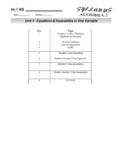Transcription of String Art Mathematics: An Introduction to Geometry ...
1 String Art mathematics Introducing GX and MI Page 1 of 10 String Art mathematics : An Introduction to Geometry Expressions and Math Illustrations Stephen Arnold Compass Learning Technologies Introduction How do you create String art on a computer? In this lesson sequence, suitable for students at all levels of high school, we learn to create some beautiful designs based on practical principles using Geometry Expressions (GX) and Math Illustrations (MI). In the first lesson, the focus is upon the Geometry : constructing String art envelopes using geometric tools. In later lessons, we explore the Geometry and algebra behind these designs.
2 Along the way, we will be introduced to proportions, loci and envelopes and, finally, parametric and implicit forms for conics. Beginning with three points, A, B and C, joined by line segments AB and BC, we construct a third segment which traces out an envelope of lines as it is dragged. By placing the endpoints on the picture of the sail boat, we see that the curve of the forward sail may be modeled nicely by the curve of the envelope of lines. Q. Is there more than one way that the String curve formed by A, B and C may be placed to match the sail? Teacher Note: Point B can only be placed in one way: it must lie at the very front (prow) of the sail boat.
3 Points A and C may be placed in either of the other end points of the sail. Once we learn how to construct such curves, we may be able to create all sorts of interesting and beautiful patterns. String Art mathematics Introducing GX and MI Page 2 of 10 Lesson 1: Constructing String Art Curves We begin with three points, A, B and C. At present, points A, B and C are free points and tend to move around a little as we do other constructions. We can use the Coordinate tool from the Constrain menu to give A, B and C general coordinates (just use the defaults for each one). We can still move A, B and C around if we want, but this constrains their movement and lets us focus on the constructions ahead.
4 Use the Segment tool to create two segments joined at a common point, B. Draw the first segment from A to B, then the second from B to C - order does matter here. Use the Segment tool again to place another segment joining a new point D on AB and another point E on BC. Q. See what happens as you drag point D along the segment AB. Is this what you expected? Teacher Note: As you drag point D along the segment AB, it moves independently of point E. What we would like would be that, as D moves along AB, the point E will move along BC proportionately. Click on point D to select it. Hold down the Shift key and also select the segment AB on which D lies.
5 From the Constrain menu, choose Proportional and press ENTER to select the default variable t. Now, Shift-click to select both point E and the segment BC and again choose Proportional from the Constrain menu. This time, change the default ("s") to "t" so that E moves in the same proportion as D. Drag point D and observe the effect. Is the Variables panel visible? If not, go to the View menu and choose it from the Tool Panels menu. You will see each of the variables you have defined so far, including our value for "t". Q. Watch the values for t change as you drag point D: can you explain what is happening here?
6 Teacher Note: Points D and E are now moving proportionately. String Art mathematics Introducing GX and MI Page 3 of 10 Consider what is happening here. When D is halfway along AB, then E will be halfway along BC. When D lies at the start of AB (at point A), then E will lie over point B. As the value of t varies between 0 and 1, then when t = 0, D will lie on A and E on B; when t = 1, then D will lie on B and E on C. This is proportional movement. Now observe the way the third segment, DE, moves as you drag D. Can you see that it seems to trace out a curve? Click to select the segment DE and choose Trace from the Construct menu.
7 Accept the defaults. What we see here is the "trace" of the segment - a series of segment images as the control point D is dragged along segment AB, as the parameter t varies between 0 and 1 in small steps. You should now try to make some of your own String art patterns. You will see that, using this method, you have a start and an end point and what we might call a "shape" point. In the top left example, it is easy to see what points A and C do. Drag point B to see how this point affects the shape of the envelope. Complete the sets partly created for you on page to design your own works of String art.
8 Add more if you wish. String Art mathematics Introducing GX and MI Page 4 of 10 On page , four sets are all done for you. Q. Are there any shapes you cannot make in this way? Could you form a perfect circle? Could you make a curve which loops over itself? One of these is possible but the other is not: which do you think? Teacher Note: Perhaps surprisingly, it is NOT possible to form a perfect circle using such curves, but by joining together two or more such shape sets, it IS possible to build curves that loop and cross over themselves. Once you start to play, who knows what you might come up with? String Art mathematics Introducing GX and MI Page 5 of 10 Lesson 2: String Art and Proportionality In Lesson 1, we learned how to create interesting patterns using Geometry Expressions and Math Illustrations.
9 In this lesson, we focus, not on the String art itself, but on the curve described by the "strings". Q. What sort of curve do you think this is? Teacher Note: We might expect students to see a curve and assume that it is a parabola, since this is the curve with which they are likely to be most familiar. In fact, the curve IS a parabola, but we will need to be convinced of that! At the moment, we appear to see a curve traced out by virtual strings, but there is no actual curve there. Although we are looking at a set of straight lines, our mind joins the lines into a curve. What sort of curve is it? The curve produced by points A, B and C certainly looks like a parabola, but what about the others?
10 To create the curve which joins each of the strings, we use Locus from the Construct menu. Just click to select the segment DE which traces out the envelope, and choose Locus from the Construct menu. Choose the default values for t. Q. One way to think about locus is as a path traced out by a point in motion. We can see the segment DE in motion on page , tracing out an envelope of lines which form a curved shape. But can you see where a point might lie that will trace the curve shown which bounds the envelope? Teacher Note: By dividing segment DE proportionately just as we divided AB and BC, we produce a point which will trace out the curve.






